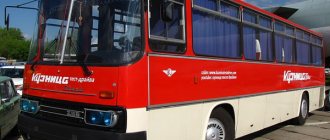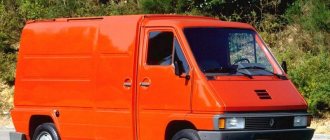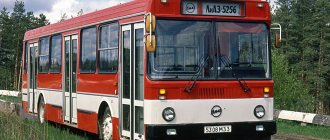City bus Ikarus 260. Photo Wikipedia
Ikarus 260 is a bus from the Hungarian company Ikarus, produced in 1971-2002 for urban and suburban routes . Over 33 years, more than 30 modifications were made. Buses supplied to the USSR were painted yellow. The body is frameless truss , welded from tubular profiles, mostly with a closed cross section.
Detailed description and structure of a purebred Hungarian
Once upon a time, back in 1967, the Hungarian designer Laszlo Finta presented to the public an unusual Ikarus 260 bus, which was the ancestor of the “rectangular” style, unprecedented for that time . The entire body is outlined as if using a ruler. Huge windows made the interior especially bright and opened up a wide view for passengers.
The most interesting feature of the new product is its modular design , thanks to which, by changing the number and position of frame elements, it was possible to assemble cars of any length, height, with a different number of doors and the location of components and assemblies. This was the Ikarus prototype of the new promising “200th” family , to which the hero of this review belongs.
Bus Ikarus 260, general view. Photo Wikipedia
The 260th is a large-class urban/suburban high-floor bus, 11 m long. The Hungarians mastered the production of the model in 1971 , from the very beginning laying in it enormous potential for modernization, which allowed it to remain on the assembly line for 33 years! This meant installing various power units and transmission units, depending on the purpose of the machines and the wishes of the customer.
The bus was distinguished by a soft ride , better conditions of comfort and passive safety for passengers, and, of course, the signature growl of the engine - it was always loud.
The advantage was that the RABA diesel engine was placed under the floor, along the frame - this made it possible to increase the number of passenger seats. But in the USSR it was decided to change the engines to domestic ones. They did not fit into the standard engine compartment at the rear, so they were installed higher, on the rear overhangs, leaving the entire rear area empty without seats.
The Ikarus 260 in Hungary was equipped with a Raba D2156 NM 6U diesel engine , in-line with 6 cylinders. The unit's power reserve was 192 hp. Torque – 696 Nm. The engine burned 28.5 liters per 100 km of road at 40 km/h and 39 per 100 km at 60 km/h. The bus reached a maximum speed of 63-66 km/h. Transmission : ZF S6-90U (manual) or Voith D851/2A4N (automatic). Number of gears – 6. All suspension – pneumatic with shock absorbers.
In this regard, the model became the first-born of Ikarus: before this , predecessor models were equipped with a mechanical suspension, which wore out in less than a year of operation. The steering was also supplied by Raba. The steering mechanism was equipped with a hydraulic booster. The brake system is drum type. The bus body was built from trusses, without a main frame: welded from hollow square steel. The body design is very simple , due to which its service life was 1000 thousand km before the first major overhaul. On average, this is 20 years of service with a warranty period of 1.5 years. And a little more about the dynamics: the bus accelerated to 40 km/h when fully loaded in 28 seconds, braking from maximum speed with a full cabin - in 13-15 seconds, covering up to 36-40 m of braking distance. The car could overcome a climb of 22%.
View of the front of the Ikarus 260 bus. Photo Wikipedia
The salon is modeled according to new principles , focused on large passenger capacity. The estimated number of passengers transported was 102 people. All seats are now single . 22 passengers can travel comfortably while sitting. The remaining 80 people ride standing and look out the incredibly huge windows with narrow or wide vents with black plastic locks. Wide storage areas can allow up to 6 people to enter and exit at the same time, which simplifies the boarding process at stops during peak hours.
The 260s were produced in the “city bus” (three 4-leaf swing doors) and “suburban” (two 2-leaf planetary doors) versions. In the latter, the number of doors was one less - usually there was no middle door, although in the late 80s modifications of commuter buses without a rear door appeared.
Another innovation is porous rubber headrest handles on the chairs. These elements are also new examples of the introduction of passive safety equipment: when you hit such a handle, it gently took the entire impact and did not injure you, but gently damped the load.
Armchairs - high foam cushions provided phenomenal comfort for those times. The ventilation was not comparable to domestic equipment, but passengers complained about heating - in cold weather there were clearly not enough stoves - the bus was cold. The floor was covered with linoleum or rubber. The quality of these materials left much to be desired, since in some batches they wore out very quickly.
the driver’s workplace as comfortable and safe as possible, even by modern standards. A person does not get tired when working for a long time. The instruments are informative, the switches are convenient. There is no need to reach anywhere - everything is at hand.
Modifications
| Modification | Description | External signs | Door formula |
| Ikarus 260.00 | First model of the 260 series | Small windows in all windows, the inscription “IKARUS” on the front in large letters, like the predecessor Ikarus 556 | 4-4-4 |
| Ikarus 260.01 | The first modification, which began to be supplied in 1972 to the Soviet Union | It differs from 260.00 in the inscription “Ikarus” on the front in smaller letters, shifted to the right towards the turn signal, and a window through the window. Since 1981, the vents have become larger in all windows. It allowed to accommodate only 22 seated passengers, thanks to which it was possible to raise the full capacity to 107 people. These hard workers, along with their articulated “brothers” - the 280 Ikarus, were used on the busiest urban routes. It is characterized by three doors, wide windows, three-row seating, a wide aisle and large storage areas. There were single seats on the left along the direction of travel, and double seats on the right side of the exits. | 4-4-4 |
| Ikarus 260.02 | Produced for the GDR | There are no windows, the driver's cabin is not separated from the rest of the cabin | 4-4-4 |
| Ikarus 260.03 | Produced according to orders from Budapest | Planetary double doors, large windows | 2-2-2 |
| Ikarus 260.04 | Produced for Poland | Screen doors like 260.01—260.02, large windows like 260.03 | 4-4-4 |
| Ikarus 260.06 | Urban | Engine Rába D2156HM6U, transmission - automatic Praga 2M70. Screen doors, since 1985 - planetary. | 4-4-4 and 2-2-2 (since 1985) |
| Ikarus 260.18 | Delivered to some cities of the USSR in 1980-1984 | An automatic transmission Lvov-3 is installed. Screen doors and large windows. Interior and decorative lining as in 260.01 | 4-4-4 |
| Ikarus 260.20M | Suburban | Large windows, missing cf. door. | 2-0-2 |
| Ikarus 260.25 | Modification for Turkey | Small windows in all windows, screen doors | 4-4-4 |
| Ikarus 260.27 | Suburban | The middle door and planetary doors are missing. The body had 2 planetary doors - front and rear. By installing seats in 4 rows, it was possible to increase the number of seated passengers to 40 people - sacrificing the width of the aisle and reducing the size of the storage areas. | 2-0-2 |
| Ikarus 260.30M | |||
| Ikarus 260.32 | Suburban | Middle door missing | 2-0-2 |
| Ikarus 260.37 | An improved modification that replaced the Ikarus 260.01 in 1984 and was supplied to the USSR until 1989 | Wide windows, updated interior design, black handrails, partition with sliding door | 4-4-4 |
| Ikarus 260.43 | Suburban, supplied to the GDR | Externally it differs from others in the location of two screen doors: one in the front, one in the middle, the back one is missing. The seating arrangement is four-row (34 seats in total). In the middle of the cabin there is one large storage area. There are 5 seats in a row in the stern. | 4-4-0 |
| Ikarus 260.45 | Urban. Produced for Budapest from 1986 to 1991. | Engine - Rába D2156 HM6UT or Rába D10 UTS 150-155, gearbox - automatic ZF 4HP 500-590. Planetary doors. Partition with sliding door. | |
| Ikarus 260.46 | Urban. Produced for Budapest from 1986 to 1992. | It differs from modification 260.45 only in the gearbox - automatic Voith Diwa D851.2 | |
| Ikarus 260.47 | |||
| Ikarus 260.50 | Modernized modification 260.37, supplied in 1990-1991. | “Eared” seats, driver’s cabin partition without a door, fluorescent lights | 4-4-4 |
| 2-2-2 | |||
| Ikarus 260.51 | Modernized version 260.27 for the USSR. | The body had 2 planetary doors - front and rear. By installing seats in 4 rows, it was possible to increase the number of seated passengers to 40 people - sacrificing the width of the aisle and reducing the size of the storage areas. | 2-0-2 |
| Ikarus 260.52 | |||
| Ikarus 260.54A | Exists in a single copy in Hungary | The middle door is moved forward by one window section | 2-2-2 |
| Ikarus 260.54C | Suburban | 2-0-2 | |
| Ikarus 260.57 | |||
| Ikarus 260.71 | |||
| Ikarus 260.73A | |||
| Ikarus 260.90 | |||
| Former Ikarus 280 (Ikarus 280K) | Overhaul of Ikarus-280 buses by cutting off the trailer | Sometimes received the official designation Ikarus 260 (280) | 2-2-2 (280.48 and 280.64); |
| 4-4-4 (280.33) |
- 261 – “mirrored” 260, intended for use in countries with left-hand traffic. The controls have been moved to the right, the doors to the left. The bus founded an entire subclass in the “200th” Ikarus family, differing in length and layout of units - for every taste and for any market. They had their own indexes:
- 263 – extended 12-meter version. Initially developed for export to the GDR, then for use in Hungary.
- 266 - differed from the 260th in its rear-engine layout and 2 doors - front and center.
Modifications
According to the classification given in various Internet sources, we counted 36-37 versions of these machines plus (announced in the title) a car in the style of Ikarus 260, designed for the production of a trolleybus. But the main differences are only in the number of doors and minor changes in appearance. There have been no design features in more than 30 years of production. True, different engines and gearboxes were installed on the buses, but this process was so streamlined that even the frames were all the same, unified for more than 5 types of engines. Below are the most common modifications.
Main “Soviet” modifications:
• Ikarus-260.01 – the former Soviet state received the first cars with this index. The bus was equipped with a Raba-D2156HM6U diesel engine. The design of these “city tramps” was distinguished by narrow window vents, handrails and paneling were white. The front doors led directly into the salon; the driver did not have a separate exit. It differs from the basic 260.00 version in that the “Ikarus” inscription is in a smaller font, closer to the right turn signal. Three screen doors (4-4-4).
• Ikarus-260.27 – this “Hungarian” came to the USSR only in 1981 and was supplied to the country for 7 years. A suburban version without a middle door, the rest of the doors were solid hinged with pneumatic drives. The bus accommodated 40 seats for passengers traveling in comfort.
• Ikarus-260.37 - a replica of Ikarus-260.01, supplied from 1984 to 1991. The differences are only in the design: the windows now occupied half of each window, the bus received new seats, light gray interior lining and black handrails. In 1988, a fenced off driver's cabin with a door to the salon appeared. The front entrance door was given half to the pilot and half to the passengers.
Other modifications with visible differences:
• Ikarus 260.02 were delivered to the GDR, special feature: without vents on the windows.
• Ikarus 260.03 was sent to the capitals of Hungary and Czechoslovakia. The buses were equipped with retractable doors and large windows for improved interior ventilation.
• Ikarus 260.04 for Poland was manufactured with 4-leaf doors and large windows.
• Ikarus 260.43 A suburban version without a rear door, found in the vastness of the USSR in the European part of the country.
• Ikarus 260.50 was a modernized version of 260.37, it appeared in our area in the early 90s, but is rare - purchases of vehicles have sharply declined.
• Ikarus 260.54A – a unique version in one copy: the middle door is shifted forward by one window section. Only the Hungarians know why such modernization was needed.
Basic information, characteristics
- Manufacturer/manufacturer where the equipment is produced/manufactured. Ikarus (Ikarus) is a Hungarian bus manufacturing company specializing in the production of city, intercity and special buses. Founded in 1895 as a blacksmith and carriage workshop in Budapest. In the 1980s, it reached an annual production volume of up to 12 thousand cars per year, which placed Ikarus among the largest bus manufacturers in Europe. Currently a small private company.
- Purpose. Urban, suburban.
- Class. Big.
- Body type. Frameless truss welded.
Ikarus 260
Material from Wikipedia - the free encyclopedia
Skip to navigation Skip to search
Ikarus 260
- a Hungarian bus, produced in 1971-2002 for urban and suburban routes. Over 33 years, more than 30 modifications were made. Buses supplied to the USSR were painted yellow. The bus body is frameless truss, welded from tubular profiles, mostly with a closed cross section.
From 1993 to 1998, at the SVARZ and YaAZ plants, as part of the overhaul of the Ikarus 280, the trailer with the articulation unit was dismantled and the rear platform from the trailer or from a decommissioned bus was mounted. The result was a bus structurally similar to the Ikarus 260.
Also, in several cases, the Ikarus 280 was shortened, but the rear platform was not mounted - an end rear mask was installed. These buses worked as technical assistance, in particular in Minsk.
In St. Petersburg, Samara, Chelyabinsk and Omsk, such buses were also used on city routes.
Modifications[ | ]
ModificationDescriptionExternal characteristicsDoor formula
| Mostly cars have survived to this day. Ikarus 200 series, which began to be produced in the late 60s. These are well known buses with an angular body, in keeping with the fashion of those years. Only a limited number of models from this family were supplied to the USSR in large quantities - long-distance Ikarus 250,255,256 and urban Ikarus 260,263,280,283. The Ikarus-260 city bus is a short (so-called “Solo”) version of the 280 model. the Ikarus-556 , which was obsolete by the early 70s . The first prototypes were built in 1971, and already in 1972 serial production of the new model began. Like other 200 series buses, the Ikarus-260 had an angular body and wide windows - a similar design was fashionable in the 70s. The engine of the Ikarus-260 was located in the base, which distinguished it favorably from all Soviet city buses. In the USSR, until the end of the 80s, a front or rear engine layout was adopted, which significantly reduced the passenger capacity of the cabin. The bulky size of Soviet engines prevented the engine from being placed under the cabin floor. The Hungarians equipped their city cars with a more compact Raba diesel engine , which could be “hidden” under the floor. Most often, the bus was equipped with an automatic hydromechanical transmission, but there were also varieties with a manual transmission. The suspension of all wheels is pneumatic, adjustable body position, power steering. Ikarus-260 was also much more comfortable than Soviet cars. The engine was hidden under the floor - and this reduced gas pollution in the cabin. It became possible to create at the same time a spacious rear area and a comfortable driver's cabin. Three wide four-leaf doors led into the salon, allowing 6 people to disembark or board at the same time.
The minimum number of seats and a large rear area made it possible to increase the cabin capacity to 100 people. Ikarus-260 buses began to arrive in the Soviet Union about a year after the start of their serial production - in 1973. However, they were not supplied to all cities of the Union. Deliveries of “short” Ikarus were carried out only to Ukraine, Belarus, the Baltic states and certain cities of Russia (for example, Leningrad). Most of Russia did not purchase the 260th model, including the capital, Moscow.
of Ikarus-260 buses ceased with the collapse of the Union - in 1991. However, the production of buses of this model lasted until 1998. However, since 1993, Hungary itself began to use a new generation model - Ikarus-415, and the 260s were exported to some Asian and African countries. Ikarus-260.01 is the first modification that began to come to the Soviet Union. These cars had narrow 1/4-window windows, which, moreover, were located through one window. The driver's cabin was separated from the passenger compartment by an incomplete partition, while both front door wings led into the cabin, but the driver did not have a separate exit. Distinctive features of the Ikarus-260.01 were white handrails in the cabin, light brown seats, and white interior trim. Ikarus-260.01 bus was equipped with a Raba-D2156HM6U engine with a power of 192 hp. Ikarus-260.27 is a suburban modification of the 260th Ikarus, its production and export to the USSR began in 1981. This bus did not have a middle door, but the other two were not hinged, but hinged. The number of seats was increased to 40 due to the absence of the middle door and the use of a four-row seat setup. The shape of the backs of the chairs was also slightly changed. Ikarus-260.27 came to the USSR until 1988. Ikarus-260.37 is an improved modification that replaced Ikarus-260.01 in 1984 and was supplied to the USSR until 1991. Unlike the previous model, the bus windows have become much wider. Now they occupied 1/2 of the window and were located in each window, which improved the ventilation of the cabin. The interior design has changed - the handrails are black, the seats are dark brown, and the interior trim is light gray. In 1988, the Hungarians began to separate the driver's cabin from the passenger compartment with a solid partition for cars supplied to the USSR. At the same time, the front door leaf was completely given to the driver. It must be said that the second door was also often not opened by the drivers themselves at their own request, which brought inconvenience to passengers. Many drivers expanded the cabin themselves, with the cabin partition covering the entire front door. Ikarus-256 is an intercity model of Ikarus 200 series, which can most often be found on the streets of our cities. Ikarus-256 began to be produced somewhat later than 250 and 255 - in 1977. Initially, the bus, like the Ikarus -255, had two mechanical doors and a 192 hp engine. After modernization in 1980, the bus gained an automatic front door and a more powerful engine.
The standard color for cars delivered to the Soviet Union was red with white underneath. Ikarus-256 was produced until 1998, when production of the legendary 200 series of Hungarian buses was stopped. After this, the company tried to launch the production of the modernized C56 model, but this attempt was not successful due to strong competition in the tourist bus market in Europe. Buses of the 256th model are 1 meter shorter than Ikarus-250 . However, their capacity has decreased slightly compared to the 250 model due to the absence of a refrigerator in the rear of the cabin. However, in many Kharkov cars the rear part is occupied by a spacious “sofa”. The fact is that instead of the original Raba engine, the bus is often equipped with a Yaroslavl engine, which takes up more space. Due to this, it is necessary to dismantle the back row of five seats and instead arrange a kind of “sleeping berth”.
But in the Soviet Union, it and its larger “brother” - Ikarus -250 - were the most comfortable buses that could be found on intercity lines. THIS IS INTERESTING: Bus man And now Ikarus -256 serves many intercity routes connecting our city with neighboring regions. Many cars are also used for tourist trips, and some are used by enterprises to transport workers. Technical characteristics of the Ikarus-260 bus:Overall dimensionsWeight and capacity of the busEngineGearbox | ||
| Width, mm | 2500 | |
| Height, mm | 3100 | |
| Base, mm | 5400 | |
| Front overhang, mm | 2460 | |
| Rear overhang, mm | 3140 | |
| Ground clearance, mm | 350 | |
| Floor level, mm | 920 | |
| Curb weight, kg | 9000 | |
| Total weight, kg | 16000 | |
| Total number of seats | 102 | |
| Number of seats | 22 | |
| Number of standing places | 80 | |
| Engine make | Raba-D2156NM6U | |
| engine's type | diesel | |
| Working volume, l | 10,349 | |
| Number of cylinders | 6 | |
| Power, hp | 192 | |
| Torque, Nm | 696 | |
| Fuel consumption at a speed of 60 km/h, l/100 km | 28,5 | |
| Fuel consumption in the urban cycle, l/100km | 39 | |
| Fuel tank volume, l | 250 | |
| Maximum speed, km/h | 66 | |
| ZF S6-90U | Voith D851/2A4N | |
| Gearbox type | mechanical | automatichydromechanical |
| Number of gearbox stages | 6 | 6 |
| Minimum turning radius, m | 10,5 | |
| Maximum elevation angle, % | 22 | |
| Braking distance at a speed of 60 km/h, m | 36,6 | |
| Tires | 11.00 R 20 |
Overall dimensions of Ikarus-260
For self-assembly
Ikarus 260.00First model of the 260 seriesSmall windows in all windows, the inscription “IKARUS” on the front in large letters, like its predecessor Ikarus 5564-4-4Ikarus 260.01The first modification, which began to be delivered in 1972 to the Soviet UnionDifferent from 260.00 with the inscription “Ikarus” on the front in smaller letters, shifted to the right towards the turn signal, vents through the window. Since 1981, the windows have become large in all windows. 4-4-4Ikarus 260.02 Manufactured for the GDR. There are no windows, the driver's cabin is not separated from the rest of the cabin. 4-4-4 Ikarus 260.03 Manufactured according to orders from Budapest and Prague. Planetary double doors, large windows 2-2- 2IKARUS 260.04 was designed for Polish-hire doors like that of 260.01-260.02, large windows like that of 260.034-4-4IKARUS 260.06IKARUS 260.18, some cities of the USSR in 1980-1984 were an automatic gearbox “Lviv-3”. Smile door and large outlets. and decorative cladding like 260.014-4-4Ikarus 260.20M Suburban Large windows, missing cf. door.2-0-2Ikarus 260.25Modification for TurkeySmall vents in all windows, screen doors4-4-4Ikarus 260.27SuburbanMissing the middle door, planetary doors2-0-2Ikarus 260.30MIkarus 260.32PurigorodnyMissing the middle door2-0-2Ikarus 260.37An improved modification that replaced yourself Ikarus 260.01 in 1984 and was supplied to the USSR until 1989 Wide windows, updated interior design, black handrails, half-partition of the front door 4-4-4 Ikarus 260.43 Suburban No rear door 4-4-0 Ikarus 260.45 Ikarus 260.46 Ikarus 260.47I karus 260.50Modernized modification 260.37 , delivered in 1990-1991. “Eared” seats, partition of the driver’s cabin without a door, fluorescent lamps 4-4-42-2-2Ikarus 260.51Modernized version 260.27 for the USSR.2-0-2Ikarus 260.52Ikarus 260.54A Exists in a single copy in Hungary [1]The middle door is shifted forward by one window section2-2-2Ikarus 260.54CSuburban2-0-2Ikarus 260.57Ikarus 260.71Ikarus 260.73AIkarus 260.90Former Ikarus 280 (Ikarus 280K)Overhaul of Ikarus-280 buses by sawing off at flail2-2-2 (280.48 and 280.64);4-4-4 (280.33)THIS IS INTERESTING: Liaz 525636
View from the front of the bus View from the back of the bus
Ikarus 260T[ | ]
Main article: Ikarus-260T
Only prototypes were produced, working in Budapest and Weimar. Tajikistan and the DPRK assembled their own versions of the Ikarus-260T with electrical equipment of both Russian and local North Korean production. The latter are currently operating in Pyongyang, assembled at the Pyongyang Trolleybus Factory as Chollima 951.
Literature[ | ]
- Magazines "Behind the wheel"
- Truck World Magazine
- “Ikarus buses, series 200”, design features, operation, maintenance, repair.
- “Ikarus buses, design and technical operation”, Transport, 1976.[2]
- “Manual in Russian for operating buses Ikarus 250/256/260/280”, Ikarus Karosszeria, 1990. [3]
Links[ | ]
Source: https://encyclopaedia.bid/%D0%B2%D0%B8%D0%BA%D0%B8%D0%BF%D0%B5%D0%B4%D0%B8%D1%8F/Ikarus_260
Engine/powertrain characteristics
- Model. Raba-D2156NM6U.
- Type. Diesel.
- Number and arrangement of cylinders. 6, in-line.
- Working volume, l. 10,35.
- Engine power, kW (hp)/min. 141 (192)
- Maximum torque, Nm/min. 696.
- Checkpoint. Mechanical 6-speed ZF S6-90U or automatic hydromechanical 6-speed Voith D851/2A4N, the following models are also possible: ASH 75.2-A8, Prága 2M70, LAZ-192.17, ZF 4HP 500-590.
- Front-rear axle suspension. Pneumatic, on two air cylinders - Pneumatic, on four air cylinders.
- Control fuel consumption at 60 km/h, l/100 km. 28,5.
- Maximum speed, km/h. 63-66.
Started the clutch!
The Ikarus 260 in Hungary was equipped with a Raba D2156 NM 6U diesel engine, in-line with 6 cylinders. The unit's power reserve was 192 hp. Torque – 696 Nm. The engine burned 28.5 liters per 100 km of road at 40 km/h and 39 liters per 100 km at 60 km/h. The bus reached a maximum speed of 63-66 km/h.
The transmission is standard for Ikarus: ZF S6-90U (manual) or Voith D851/2A4N (automatic). Number of gears – 6. All suspension – pneumatic with shock absorbers. In this regard, the model became the first-born of Ikarus: before this, predecessor models were equipped with a mechanical suspension, which wore out in less than a year of operation.
The steering was also supplied by Raba. The steering mechanism was equipped with a hydraulic booster. The brake system is drum type.











